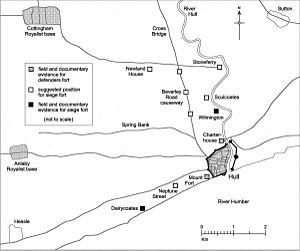Siege of Hull (1643) facts for kids
Quick facts for kids Siege of Hull (1643) |
|||||||
|---|---|---|---|---|---|---|---|
| Part of First English Civil War | |||||||
|
|||||||
| Belligerents | |||||||
| Commanders and leaders | |||||||
| Earl of Newcastle |
|
||||||
| Casualties and losses | |||||||
| Unknown | Unknown | ||||||
The second Siege of Hull in 1643 was an important event in the First English Civil War. The Royalist army, led by the Earl of Newcastle, tried to capture the city of Hull. However, the Parliamentarian forces, also known as Parliamentarians, successfully defended it. This victory was a big win for Parliament when the Royalists were doing very well in the war.
The siege stopped the Earl of Newcastle's plans to move into Lincolnshire. It also helped Parliament get back control in Yorkshire.
Contents
Why the Siege Happened
The War in Lincolnshire
In 1643, the Royalists were winning many battles. After a big victory at the Battle of Adwalton Moor in June 1643, the Earl of Newcastle's Royalist army moved into Lincolnshire. At this time, the Royalists hoped to march on London from three different directions.
Battles at Gainsborough and Lincoln
On July 16, 1643, a Parliamentarian leader named Lord Willoughby captured the town of Gainsborough. But Royalist forces quickly surrounded him. Parliament sent help under Sir John Meldrum and Colonel Oliver Cromwell. They won a battle at Gainsborough on July 28.
However, when Newcastle's main army arrived, the Parliamentarians had to leave Gainsborough. Both Gainsborough and Lincoln then fell to the Royalists.
The Fairfax Family in Hull
Meanwhile, Lord Fairfax and his son, Sir Thomas Fairfax, had escaped to Hull. Hull was the only place in Yorkshire still controlled by Parliament. The military governor of Hull, Sir John Hotham, was removed because he was secretly planning to give the city to the Royalists.
The people of Hull asked Lord Fairfax to take charge on July 22. He quickly made Hull stronger by adding defenses. He also set up a base in Beverley and launched attacks on Royalist areas in Yorkshire.
Newcastle had to make a choice. He could continue towards Boston and the eastern parts of England. But he knew Lord Fairfax's army was still strong in Hull behind him. Fairfax's attacks, like one near York, made Newcastle realize he had to deal with Hull first. So, he turned his army back north to face Fairfax.
Royalists Take Beverley
Newcastle's army was very large, with 12,000 foot soldiers and 4,000 horsemen. They also had huge cannons. Fairfax's smaller force decided to retreat back to the strong defenses of Hull. They left Beverley on August 28.
When the Royalist army entered Beverley, they took many things from the townspeople. They took cattle and goods and sent them to York. Within a week, Fairfax's army was safely back inside Hull.
The Siege Begins
Newcastle's army followed closely and surrounded Hull. They started building earthworks and setting up their cannons to attack the city. The Royalist cannons began firing on September 2. However, their shots did not do much damage because the cannons were too far away from Hull's walls.
The Royalists tried to build their earthworks closer to the city. But one of their new forts, called Fort Royal, was captured and destroyed by the defenders within a week.
Flooding the Land
On September 14, Lord Fairfax ordered the sluices (water gates) to be opened. He also had the banks of the Humber River broken. This was done during the first siege of Hull in 1642 too. This action flooded the land around Hull for up to two miles. This made it very hard for the Royalist army to move and attack.
Help Arrives for Hull
Parliamentary warships, the Lion and the Employment, arrived to control the Humber Estuary. They brought in important supplies for the defenders.
On September 22, Oliver Cromwell crossed the Humber River from Lincolnshire. He brought more weapons and ammunition for the defenders. He joined the Fairfaxes in defending the city. Four days later, Sir Thomas Fairfax sent some of his cavalry back across the Humber to join other Parliamentarian forces. Sir John Meldrum also brought 500 more soldiers to help defend Hull.
Royalist Attack and Parliamentarian Counterattack
On October 9, the Royalists tried to storm Hull's defenses. They captured some outer areas, but they could not take the city itself. Two days later, on October 11, the defenders launched a counterattack. About 1,500 men, including soldiers, sailors, and townspeople, took part.
Led by Meldrum, they pushed back the Royalists. They captured several Royalist positions and some heavy cannons.
What Happened Next
On October 12, Newcastle realized he could not win. He gave up the siege and took his army back to York. Hull celebrated this victory with a public holiday every year until the Restoration of the monarchy.
On October 11, the Royalists also lost another important battle at Winceby in Lincolnshire. These two defeats ended the Royalists' hopes of marching on London. They were now on the defensive. The Parliamentarians then began to advance into Yorkshire. This led to Newcastle being surrounded in York and the major Battle of Marston Moor.
See also


